Menu
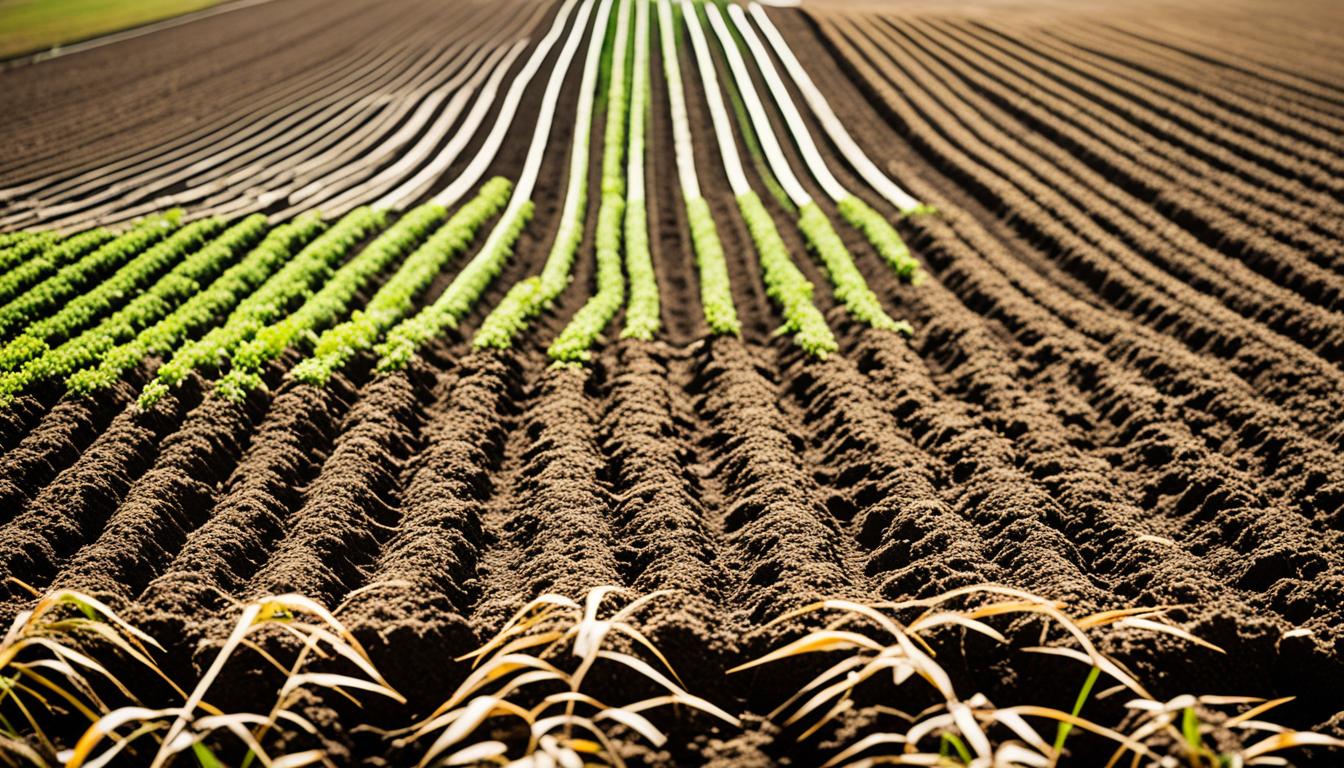
The US farm sector is looking at a 24% dip in its net cash this year. It’s the biggest fall in ten years. This sharp drop shows big changes in how crops are selling. It’s really important to know these trends to keep up with the tough market.
Today, technology like satellites, drones, and sensors is helping agriculture. They give farmers quick and accurate info about their crops. This helps make the crops healthier, fix problems fast, and use water and plant food better. With more focus on green farming, these trends are even more essential.
Knowing crop market trends is key in agribusiness. It looks at patterns and changes in crop health, tech, and economic activities in farming. Understanding these trends helps businesses make better plans.
Crop market trends are about studying changes in the farming market. They’re important for everyone in farming. Keeping an eye on trends helps businesses get ready for the future. It also ensures they make smart choices. This is why getting regular updates from the farming industry is critical.
Looking back, crop market trends have changed a lot. This has been because of new farming methods and machines. Agribusiness stats from the National Agricultural Statistics Service (NASS) help us see how the industry has evolved. They’re key to understanding the business today.
Every year, NASS starts predicting U.S. crop output with a winter wheat and rye sowing report in January. By May, they start giving monthly estimates for crops like winter wheat. And by August, they cover more crops. The World Agricultural Outlook Board (WAOB) also helps with monthly forecasts for world food crops.
“The NASS Crop Production report and the World Agricultural Supply and Demand Estimates (WASDE) report, released between the 9th and 12th day of each month, provide crucial data that informs agribusinesses of current market conditions and future trends.”
In June, NASS surveys over 125,000 farmers to get data on crops, grain stocks, and animal supplies. This survey is key. It gives not just the total planted area but also early harvest projections. These details are vital for agribusiness plans.
Global crop market dynamics are key for those in the agricultural field. It’s important to understand what affects this sector. Let’s explore the main influences here.
Today, sustainable farming and increasing yields drive the market. More farmers are using methods that are better for the environment. These include Biologicals and Plant Growth Regulators (PGRs), which are eco-friendly. Early in 2023, Northern America saw strong growth with high product prices before planting. This helped reduce losses later.
The use of Biologicals is also growing in the specialty crops area. This shows the push for value-driven growth.
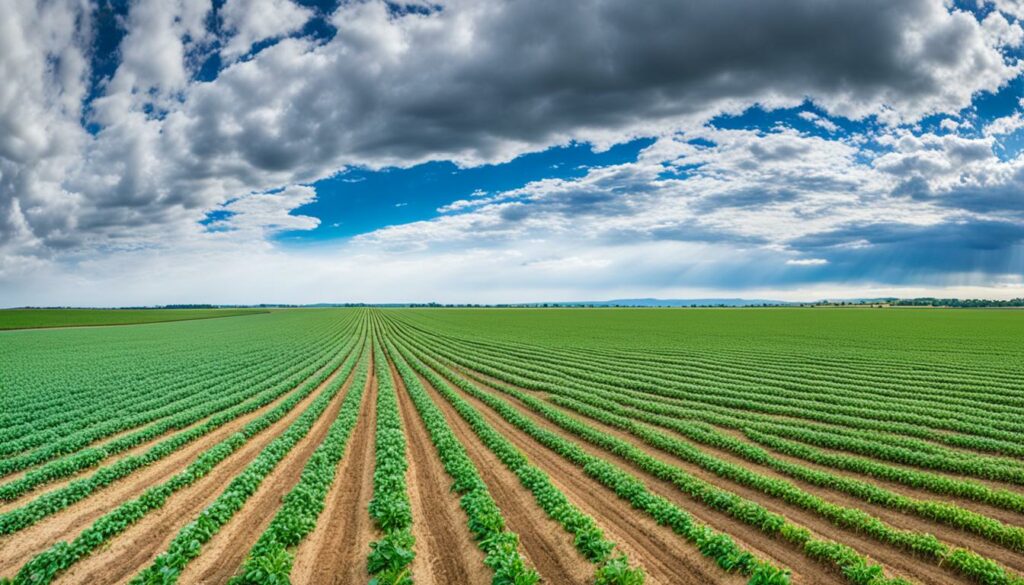
But, the crop market is not without challenges. Factors like high inflation and rising interest rates are expected to slow demand. The World Bank predicts a 4% drop in its commodity price index for 2024, after a big fall in 2023. This was one of the largest declines since the start of the pandemic. It shows there are big economic questions.
Growth is expected to be flat with a small decrease. This highlights the need for careful planning to face these challenges.
The situation also opens up new chances. New technology like better forecasting is changing how the market works. For the agrochemicals sector, a lot of important patents are ending, creating new chances for growth.
Changes in trade rules and the growing need for food bring new opportunities. Stakeholders must be quick to grab these chances as things change.
The global crop monitoring market is changing quickly, thanks to new technologies. These changes help farmers predict crop yields better and keep up with trading trends.
Satellite imagery is now key in tracking crops. It gives a wide view, meaning farmers can check their fields without being there. This is great for predicting how much crop will be harvested. It also helps farmers find and fix issues in their fields quickly.
Drones and sensors are making agricultural data more detailed and accurate. They take pictures and collect data at a high level, helping to map fields, check on soil, and scout crops. This data is put into digital farming systems to make better decisions. This improves crop growth and influences trading trends.
Data analytics are vital in modern crop monitoring. They turn lots of different data into useful advice. Powerful software processes data from many sources, like satellites, drones, and sensors. This analytics fine-tunes farming, saves resources, and predicts crop yields well.
| Technological Aspect | Benefits | Market Impact |
|---|---|---|
| Satellite Imagery | Expansive survey capabilities without on-field presence | Improves efficiency, assists with accurate crop yield projections |
| Drones and Sensors | Granular data collection, high-resolution imagery | Enhances precision farming, shapes agricultural trade trends |
| Data Analytics | Translates data into actionable insights | Optimises resource usage, improves yield predictions |
The future of crop monitoring involves AI, ML, and IoT. These technologies are boosting productivity. They are crucial in fighting global hunger and pushing agricultural trade trends forward.
Climate change heavily affects crop yields. It transforms farming and the economy, mainly through changing weather patterns. This shift requires us to act and find new ways to deal with the changes.
We can see the weather changing before our eyes. For example, U.S. farms face huge disruptions, impacting an economy of $300 billion every year. This includes lower protein in plants like alfalfa and soybean due to more CO2.
In addition, crops are suffering more losses. In 2012, Michigan’s cherry crop faced a $220 million loss due to higher night temperatures. These issues underline the urgent need for action.
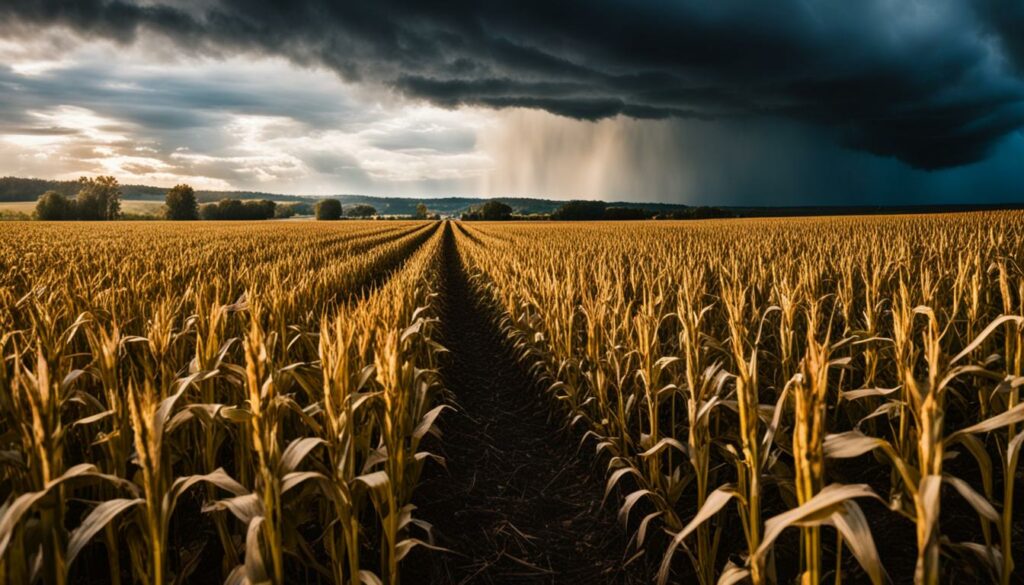
Heatwaves are also on the rise, causing over $1 billion in losses yearly. Weeds, pests, and fungi are thriving in these adverse conditions, putting the food supply at risk. It’s clear that we must act fast to protect our crops.
We are working hard to combat these changes. Strategies like precision farming and adaptive practices help protect crops from the worst effects. U.S. farmers, spending more than $11 billion each year to fight weeds, are leading this effort.
Keeping an eye on crop market trends is critical. By doing so, we can make quick changes to protect our food production. Everyone, from farmers to policymakers, must work together and use new ideas. This way, we can fight the many challenges that climate change brings.
The key is to combine adapting to new conditions with using the latest technology. Together, these create a strong foundation for the future of farming.
The farming sector varies in each region, influenced by local climates and the types of crops grown. Technology also plays a key role. This analysis gives an in-depth look at the farming industry in North America, Europe, Asia Pacific, and Latin America. It covers the latest trends shaping these areas’ agriculture.
In the global agriculture scene, North America is a major player, led by the United States and Canada. A recent report shows that wheat prices at the Chicago Board of Trade jumped from $5.53 to $6.87 per bushel in late spring. This rise reflects the ups and downs of the grain market, responding to various factors worldwide. In Kansas, a big wheat-producing state, the wheat’s quality dropped from 57% to 31% over a few months. This change was due to tough weather conditions.
Europe’s farming varies greatly due to different climates and rules. Recent updates from the IKAR analysts have stated a decrease in Russian wheat production. This drop is blamed on bad weather. The USDA’s May report also predicts a lower wheat output. Such news shows how vital it is to have good forecasts for harvesting. This helps use resources wisely and keeps the market steady.
The Asia Pacific region is on the rise in the farming world thanks to growing demand and new technologies. China and India are big players here, with their vast farming and exporting. A report by OECD and FAO says that cereal production could jump up by 13% by 2027. This points to a bright future for the region.
Latin America is famous for its wide fields that grow crops like soybeans, coffee, and sugarcane. It enjoys strong sales abroad and is picking up agritech quickly. Reports show how countries like Brazil and Argentina are boosting their farming. They are doing this by using new methods and making better harvest predictions. This leads to steady growth for their farming output.
| Region | Key Crops | Production Trends |
|---|---|---|
| North America | Wheat, Corn, Soybeans | Increase in price volatility, deteriorating crop quality |
| Europe | Wheat, Barley, Sugar Beet | Decrease in Russian wheat output, harsh weather impact |
| Asia Pacific | Rice, Wheat, Fruits | Expected rise in cereal production, strong market growth |
| Latin America | Soybeans, Coffee, Sugarcane | Enhanced production capabilities, strong export markets |
This part looks at major agricultural goods and their prices. Knowing about these things is key for anyone in farming or food business. It helps them deal better with the changing costs and figures.
In the U.S., California is top in growing things. Its crops were worth more than $33 billion in 2017, much more than any other state. Washington leads in apples, and Florida in oranges.
The U.S. makes lots of milk, over 218 billion pounds each year by 2019. That’s a 70% jump from 1980. In cotton, the U.S. was selling a lot more abroad, with 85% of it now going to other countries, up from 40% in the 1990s.
The cost of crops and animals can change a lot. In 2020, crops cost 18% more, and 14% more in 2021. In 2022, it rose by 8%. On the other hand, animal prices dropped by 7% first, then went up by 18% the next year.
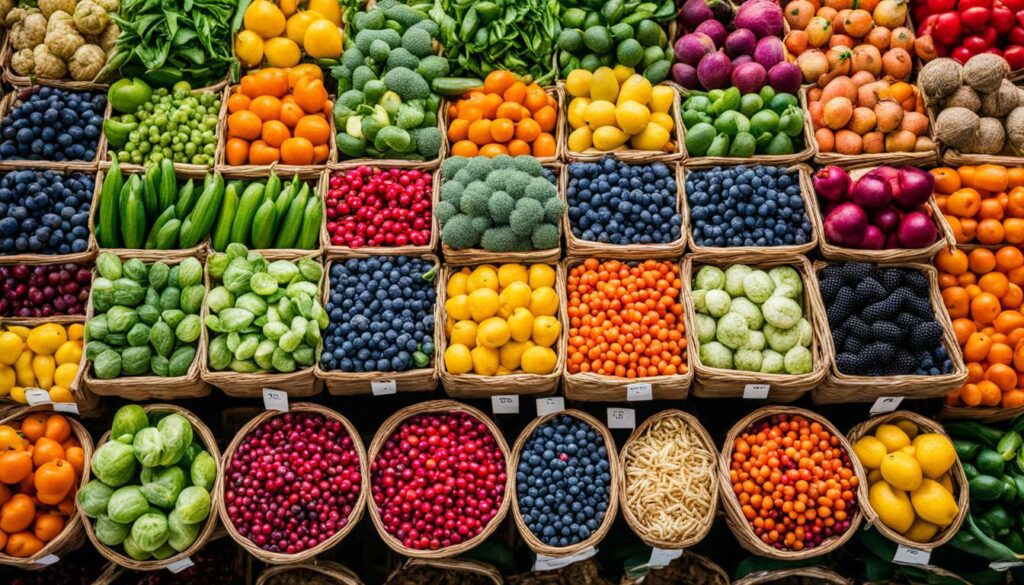
Certain crops have been through ups and downs too. For example, corn was at $6.80 a bushel, but will balance out at $4.30. Soybeans fell from $13.00 to $10.30 a bushel, and wheat from $9.20 to $5.70 a bushel.
| Commodity | Projected Price | Peak Price |
|---|---|---|
| Corn | $4.30 per bushel | $6.80 per bushel |
| Soybean | $10.30 per bushel | $13.00 per bushel |
| Wheat | $5.70 per bushel | $9.20 per bushel |
Knowing about these changes helps make better decisions. It shows how farming goods are worth looking into in many ways.
The agricultural sector is always changing. As we approach 2024, big shifts are expected. These changes are influenced by several factors that we will explore.
Looking ahead to 2024, the agricultural sector faces both growth and challenges. The US agricultural net cash income is predicted to drop by 24%. However, agritech innovations offer chances for growth.
On the other hand, crop sales and working capital within the US are likely to see reductions. Despite recent trends, a decrease of 6% in working capital is predicted. Also, key crops’ prices may drop, affecting farmers. For example, corn prices might go down by 5%. This could lower corn growers’ profits, even though up to 40% of their costs come from fertilisers.
In 2024, several key factors will shape the market. For example, the Consumer Price Index (CPI) for food went up by 0.1% in March. This shows ongoing inflation.
Buying food to eat at home might cost 1.2% more. And food purchased away from home might be up by 4.2%. Beef prices are expected to jump by 3.3%. Yet, pork prices may not change, illustrating varied trade impacts.
Poultry, sugars, and sweets are also forecasted to see price hikes. But, dairy, fish, and seafood prices might go down by 1.6%. In contrast, egg prices could increase by 4.8%. These trends highlight the complex nature of the market.
These forecasts help businesses get ready for what’s to come. They are essential for adapting to changes in the markets and trade.
Precision agriculture is changing farming in a big way. It uses high-tech tools like GPS, sensors, drones, and AI. Farmers can now make smart choices based on data. This boosts their crop yields and makes their work more efficient.The use of these advanced tools lets farmers manage their fields closely. This is really important in today’s farming world. It ensures every step of farming is done with great care.
Using precise methods helps farmers look after their crops better. They can use satellite images and sensor data to watch their fields closely. This way, they can quickly fix things like not enough nutrients or pests.
New tech like robots and self-driving machines also help with planting and harvesting. This makes their work faster and reduces waste.
Precision agriculture is making a big difference in money matters. In 2022, it was worth USD 9.4 billion. Experts say it will keep growing at a fast rate. Places like North America and Europe are using this tech a lot. Now, even some developing countries are beginning to use it more.This tech helps farmers make more crops using fewer resources. This in turn keeps the business profitable and the land healthy.
But, not everyone finds it easy to start using this technology. It can be costly and hard to manage all the data. This is a bigger problem for small farmers.To help, there are plans for subsidies, simple tech, and training. The goal is to make precision farming available to everyone.
The future of precision farming looks bright. Things like more AI and IoT, more self-driving machines, and a focus on personalised farming are on the horizon. These changes will make farming even more efficient. They will also support the planet through greener practices.
The crop monitoring market sees key companies making big strides with new tech and smart investments. They keep their top places by always improving their products. This helps them meet the changing needs of customers.
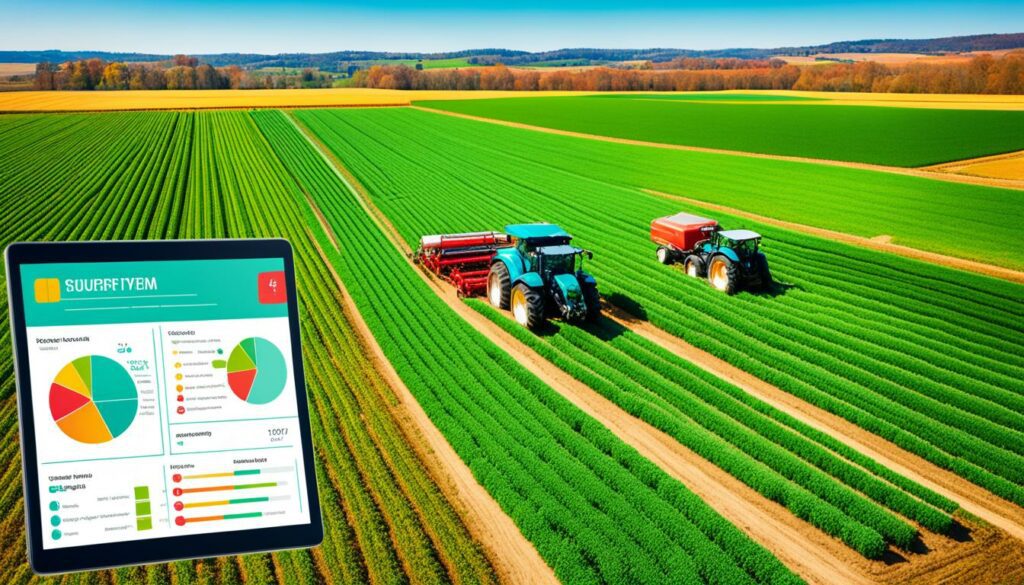
Libelium Comunicaciones Distribuidas S.L. has become important by providing strong IoT solutions. These fit well with today’s farming methods. They bring agribusiness statistics together with live data. This makes monitoring much better.
John Deere leads the way in farming innovation. Their modern tools and software help watch crops closely. This leads to better control over worldwide crop prices and better yields. Their dedication to new tech is a standard in the industry.
Raven Industries Inc. is known for its modern farming technology. It excels in precision farming and mapping fields. Their products give detailed insights into farming statistics. This helps farmers worldwide make smart choices, keeping global crop prices steady.
The farming industry is changing a lot. It’s important to know the latest news. For 2024, farm income is expected to fall by 25.5%, from 2023. This would hit $116.1 billion. Also, money from crops is set to decrease by $16.7 billion to reach $245.7 billion. Despite these decreases, farm equity is predicted to rise by 4.7% to $3.74 trillion.
The cost of producing farm goods is going up. It’s expected to jump by $16.7 billion to $455.1 billion in 2024. Also, direct farm payments from the government are due to fall by 15.9%, reaching $10.2 billion. This is paired with a drop in earnings from animal products. They’re predicted to fall by $4.6 billion to $239.8 billion in 2024.
Now, let’s look at some key farm goods. Corn sales are forecast to drop by 14.3% or $11.3 billion. Soybean sales will also fall by 10.3%, a $6.0 billion reduction.
The role of harvesting forecasting is crucial. It predicts a 24% fall in farm cash income this season. As a result, the amount of money farms have to work with will fall by 17% compared to 2023. This number also dips by 6% against the five-year average. This makes using sustainable and efficient farming methods even more important.
Studying agricultural commodities can guide us through these changes. The price of corn and soybeans might drop by 5% and 11%, respectively. Wheat prices could see a 15% decrease. But, the cost of things like fertiliser, which is a big part of running a farm, is expected to go down by 15% in 2024.
Staying on top of these updates is key. It helps us make smart choices, given the changing farm economy. This way, we can face whatever challenges lie ahead.
Global produce prices change a lot due to many reasons. Knowing these reasons helps people make smart choices. This is key in a world where the market always changes.
The way we trade around the world impacts the prices of goods. For example, in April 2024, the FAO Food Price Index went up by 0.3%. It was still 7.4% less than a year before. The FAO Cereal Price Index also rose, by 0.3%, but was 18.3% lower than in the previous April.
It’s important to understand how different crops affect trade. In April 2024, meat prices went up by 1.6%. This shows that more poultry and beef were being sold overseas. But, the price of sugar dropped by 4.4%. This reduction suggests there was a decrease in how much sugar was being traded.
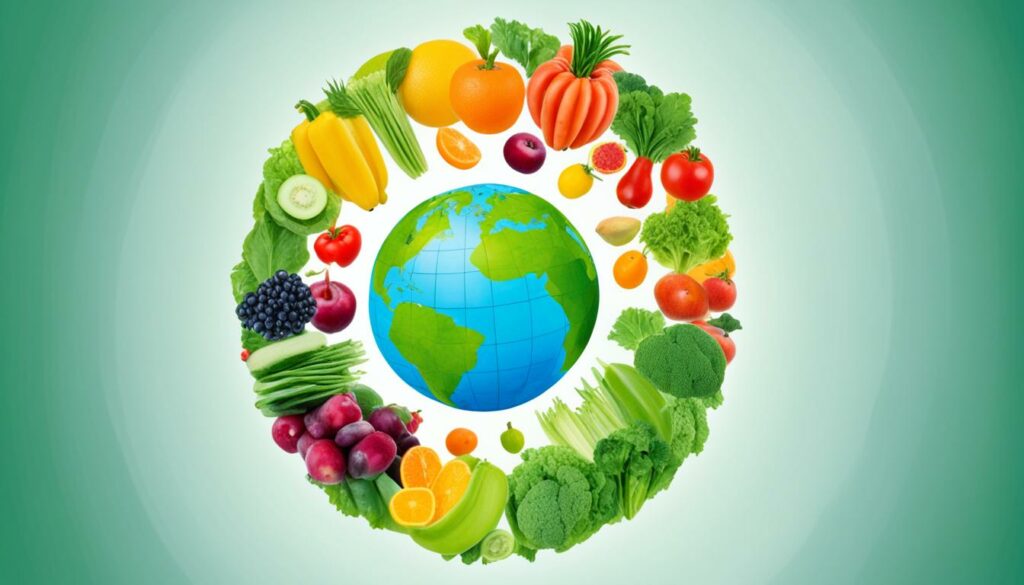
Many things influence the cost of produce. Changes in currency value can make trading more or less competitive. Also, international policies and deals can change the prices. Even problems in getting products to market, like high transport costs, can have an impact.
In April 2024, the FAO Vegetable Oil Price Index slightly improved by 0.3%. However, experts say that we need to watch crop forecasts to understand prices better. Using trends in crop markets can help reduce unpredictability and set better prices.
Table:
| Index | April 2024 | March 2024 | April 2023 |
|---|---|---|---|
| FAO Food Price Index (FFPI) | 119.1 | 118.8 | 128.7 |
| FAO Cereal Price Index | 111.2 | 110.9 | 136.2 |
| FAO Vegetable Oil Price Index | 130.9 | 130.6 | N/A |
| FAO Dairy Price Index | 123.7 | 124.0 | 129.2 |
| FAO Meat Price Index | 116.3 | 114.4 | 116.8 |
| FAO Sugar Price Index | 127.5 | 133.4 | 149.4 |
Understanding how produce prices change is crucial for staying competitive. Smart strategies are needed to do well in the global market.
Agribusiness stats provide a deep look into the industry. They help us understand production levels, market shares, and overall economic well-being. These details are vital for staying up-to-date with farming industry updates and making important choices.
Technology, including Generative Artificial Intelligence (GEN AI), is changing farming. It makes processes better, cheaper, and more innovative in crop care. This tech allows us to use large amounts of data to improve how we grow and manage crops.
“Digital twins reduce the need for expensive and time-consuming field trials, boosting efficiency in agribusiness.”
Digital tools help with regenerative farming. These tools use specific, up-to-date info to improve the health of the soil and increase crop yields. This helps the environment and makes farms run better.
Using cloud apps is great for looking after crops and soil. Farm data is growing fast, and this tech will help us keep a close eye on crops over many seasons. It makes decision-making stronger with lots of data.
As weather-proof crops become more important, tech allows farmers to see the benefits of new growing methods. This is key as there’s more need for crops like corn and soybeans for things like biofuels. It’s making the market bigger.
Global Free Trade Agreements will push the market even more. Precision farming, which uses tech like drones, makes farms run better and use less resources. This shows how farming methods are getting better with time.
Farming in ways that are good for the planet, like organic farming, is becoming popular. So are methods like using less chemicals. It’s because people care more about the environment. Growing food in vertical farms is also a response to needing more space for farming near cities.
There are more places online to buy and sell farm products. Biotech and GMOs work on making crops better and more resistant. They try to solve problems while also being careful of the environment.
Using data to understand how crops do, what market prices are, and what people want is very helpful. This info leads to smart choices in farming. Using smart farming methods that can deal with climate issues is getting more popular, too.
| Technology | Impact on Agribusiness |
|---|---|
| Generative Artificial Intelligence (GEN AI) | Optimises processes, cuts costs, fuels innovations in crop management |
| Digital Twins | Reduces need for expensive and time-consuming field trials |
| Cloud Applications | Expected to optimise crop management, soil insights, multi-season crop monitoring |
| Precision Farming Technologies | Optimises operational efficiency, minimises waste |
| Digital Marketplaces and AgTech Platforms | Enhances transparency and efficiency in transactions |
Agribusiness stats and insights are key in painting a full picture of the industry. They help with making predictions and planning wisely in the changing world of agricultural trade trends.
Crop yield projections are crucial for managing agribusiness. They help in understanding global prices. Getting these projections right aligns production with what the market needs. It affects how we make economic strategies and policies.
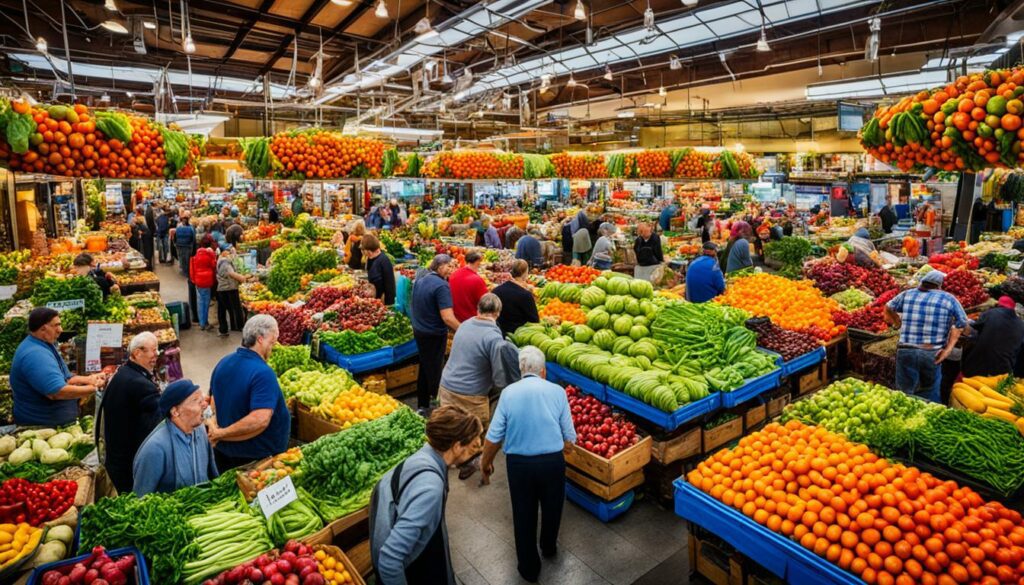
To predict crop yields, different methods are used. These include statistical models, remote sensing, and looking at past data. The National Agricultural Statistics Service (NASS) uses farm data and surveys. They also use tools like vegetation indices and UAVs to predict yields.
He et al.’s 2022 study highlights a move towards automated monitoring. The June Agricultural Survey involves over 125,000 farmers. It collects details on crop yields, grain stocks, and livestock. This detailed approach helps in making more accurate forecasts for the agribusiness.
Predicting crop yields accurately is vital for the economy. It shapes how we trade commodities and set prices. For example, the U.S. Department of Agriculture’s reports are key for understanding field crop yields.
Market movements are highly influenced by these projections. They play a big role in decisions, like what to do with record high corn production. The move towards more automated and analytical methods, as seen in studies like Pant et al.’s in 2021, is making farming more economically sound.
| Study | Technology | Focus |
|---|---|---|
| He et al. 2022 | Yield Monitoring Systems | Fruit Harvesting Data |
| Zeng et al. 2021 | UAVs with RGB Images | Crop Yield Prediction |
| Nagini et al. 2016 | Deep Neural Networks | Weather Data for Yield Prediction |
To sum up, crop yield predictions are about more than just numbers. They are about preparing strategically and planning well in the farming field. The mix of technology and detailed analysis offers a strong base for future success. It promises growth and stability in the agricultural sector.
Agricultural trade trends shape how farms and world trade interact. By watching these trends, people can make smart choices for their business and local areas. This helps everyone involved.
Agriculture trade changes affect the local scene, especially in the U.S. The U.S. sold farm products worth $178.7 billion in 2023, down $17 billion from 2022. This big drop still shows how important this trade is. It sets the price and availability of goods in local shops.
The biggest buyers are China, Canada, Mexico, and the EU. They bought 64% of the U.S. export value in 2023. What they buy affects what’s available at home. For over a decade, more than half of what the U.S. bought from abroad was plants and flowers. This shows how closely countries work in trade. Keeping an eye on these trends is vital to prevent any supply problems.
World trade rules are key in looking at farm goods. Deals, help from the government, taxes, and world events can help or hurt the trade. For example, the U.S. bought more farm goods from abroad over the years. This means, because of demand and policies, it’s relying more on global farming.
Trade rules mix with world politics too. Big farming countries like Russia and Ukraine affect the world’s prices for wheat and barley. Russia sells a lot of wheat. Ukraine makes the most sunflower seeds. Their rules shape trade and prices worldwide.
| Region | 2013-2023 Cumulative Export Value (in Billion USD) | Key Commodities |
|---|---|---|
| China | $33.7 | Soybeans, Corn, Meat |
| Canada | $30.9 | Fruits, Vegetables, Dairy |
| Mexico | $25.5 | Grains, Meat, Vegetables |
| European Union | $28.0 | Wine, Horticultural Products |
Understanding how global rules and trade mix helps me make better decisions. It keeps my business ready for what’s next.
The crop market worldwide faces many hurdles that slow its growth. These issues come from both the environment and economy. To keep the market steady, people in this field must think of new ways forward and sturdy plans. Knowing the challenges help the farming world prepare for changes and keep their work going well.
Issues like land that gets worse, not enough water, and fewer plants and animals are big problems. They make it hard for farming to stay steady over time. Our need to grow more food puts extra pressure on nature. But, new tools like precise sprayers and drones that check on crops can make a difference. Also, many are working on ways to protect crops that are kinder to our planet, like making eco-friendly products and using smart pest control.
The money side of farming also has its own set of problems. Prices changing often, how much people are willing to pay, and global money shifts can all change how much food is made. In 2020, the crop protection market’s worth was USD 60.08 billion. Experts think it will grow to USD 77.54 billion by 2025. Big names in farming are putting a lot into new ideas to help. But, keeping the money part stable is key. So, watching the latest in the farming world and having good harvest predictions is very important.
Crop market trends show changes in the farm market that matter for farmers and sellers. They’re key for making smart business choices.
The farm market has changed because of new technology, climate shifts, and worldwide economy changes. Knowing the past helps predict the future.
Global farm trade changes because of a focus on eco-friendly farming, new tech, and fighting climate change. These push the market forward.
Big challenges for farming include eco problems, market uncertainty, and financial issues. These can slow down farm growth.
Chances come from new tech, different food demands, and changing world trading rules. They offer new paths for farming success.
Satellite eyes in space help watch the land without anyone there. Farmers can check crops from a distance and farm better.
Drones and sensors give very detailed data about crops, so farmers can make very exact choices. This helps with watering, feeding, and keeping bugs away.
Data wise up farmers by turning lots of info into smart plans. Past and current data help guess how much food the farm will make, improving how they manage things.
Changing climates can mess with growing food, making seasons odd and weather severe. Farming has to change to keep up with nature.
Smart farming, tougher crops, and saving water are ways to fight climate troubles. These methods soften the harm climate change can do to farming.
Each area’s farming is different because of its weather, the local crops, and how much new technology they use. For example, North America might lead in high-tech farming.
Important crops like wheat, corn, and soybeans change in price because of how much people need them, the weather, and what’s happening in the world market.
The 2024 plan is to grow by getting better at farming technology, meeting what people want to eat, and following new rules. This way, businesses can get ready for the future.
Using data to farm better means growing more food without using as many resources. This makes farming more effective, saves money, and helps the environment.
Big names in watching over crops include Libelium Comunicaciones Distribuidas S.L., John Deere, and Raven Industries Inc. They make farming smarter with new ideas and big plans.
New tech, more ways to sell food, and different rules are happening in farming now. Knowing about these changes keeps people on top of the industry.
How much food costs changes with what countries buy and sell, the value of money, how countries work together, and the challenges of moving food around. Understanding these is key for doing good trade.
Numbers on how much food is made, who’s selling the most, and the financial state of farming are very important. They help with planning and making smart business moves.
To guess how much food the land will make, farmers use math, looking from far with special eyes, and checking old data. This helps plan what to do and how to sell.
Local food markets change based on trade deals, aid from the government, and taxes. These can change things a lot by how much and what kind of food can come and go.
Fighting eco problems, problems with the land and water, and not being able to guess what the market will do are big issues for farming. Meeting these challenges needs new and strong ideas.